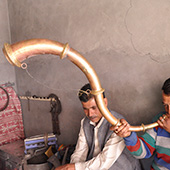Design Resource
Ransingha (Trumpet) - Himachal Pradesh
Traditional Instrument
by
Himachal Pradesh, a state of India, located in the northwest corner of the country, has a rich culture of music and dance. Music is an integral part of their life, which includes many kinds of folk songs. Himachali people never miss a chance of singing their favorite song on occasion. The folk instruments have a significant role in their life right from birth till death. Their simple way of life also reflects in their pure music. Usually, accompaniment is not needed for folk songs. But locals enjoy the merriment of these songs with their traditional musical instruments. Himachal Pradesh folk music features a wide variety of drums, including Dammama, Damanght, Gajju, Doru, etc. Non-drum percussion instruments include the Ghanta and Ghariyal, Chimta, Manjira, and Jhanjh. There are also wind instruments like Algoja, Peepni, Shehnai, Bishudi, and Ransingha. Strings Instruments include Gramyang, Riwana, Sarangi, Jumang, Ruman, and Ektara.
Most of the population at Himachal is Hindu, which has its rituals, traditions, and style of dressing. The main occupations here are farming and livestock. Local habitats also engaged in making handicrafts. Himachal handicraft items are renowned all around the world. Local music and dance reflect the cultural identity of the state. There are several fairs and festivals that are celebrated in the state. People entreat their gods through their dance and music during local festivals and other special occasions. Generally, people prefer folk music, and Himachali songs are sung in a lead voice with the chorus.
Ransingha:
Ransingha is a traditional instrument used all over Himachal Pradesh for special occasions like festivals, welcoming VIPs, marriages, etc. It is also called an Indian Trumpet. This instrument is made of two brass and copper metal curves. The instrument consists of two parts, which are joined together. Both parts are of the shape of the English alphabet C. One part is thicker and broader than the other part.
Both the parts are joined in such a way that the shape looks like the alphabetical letter S. The player blows Ransingha with great force by his mouth, which enables it to bring out a sound through the narrower and thinner end by holding it in the air. Only one or two notes can be obtained through this instrument.





